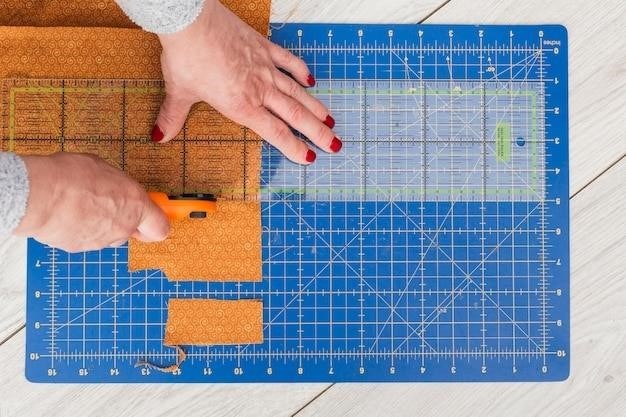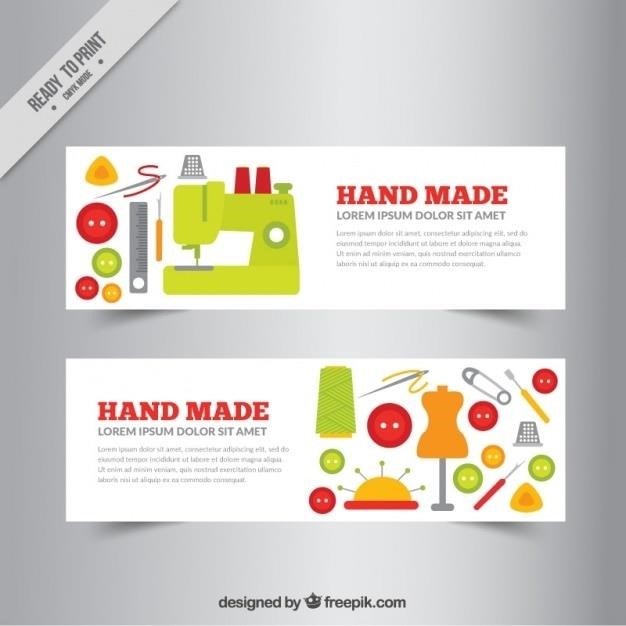Quilting Guide Bar⁚ A Sewing Machine Essential
A quilting guide bar is a handy sewing machine accessory that helps quilters sew straight, parallel lines of stitching at consistent intervals. This essential tool simplifies quilting, especially for larger projects or when maintaining even spacing is crucial. It attaches to the walking foot, providing a visual guide for accurate stitching.
What is a Quilting Guide Bar?
A quilting guide bar is a specialized accessory designed for sewing machines, specifically tailored to assist quilters in achieving precise and consistent stitching. It functions as a visual guide, ensuring that rows of stitching are spaced evenly and parallel to each other. This tool typically attaches to the walking foot of the sewing machine, offering a stable and reliable reference point for the fabric as it moves through the machine. The guide bar itself can be adjusted to accommodate various desired stitch spacing, offering versatility for different quilting projects.

The design of a quilting guide bar often features a long, straight edge that runs parallel to the direction of stitching. This edge serves as a visual marker, helping the quilter maintain a consistent distance between each row of stitching. Some guide bars incorporate markings or measurements along their length to facilitate precise spacing, while others rely on a simple, unadorned edge for visual reference. The material of the guide bar is typically chosen for durability and resistance to wear and tear, ensuring that it can withstand repeated use during quilting projects.
Quilting guide bars are considered essential tools for quilters of all skill levels. Whether you’re a beginner or an experienced quilter, this accessory can enhance the accuracy and consistency of your stitching. The guide bar helps to eliminate guesswork and reduce the risk of uneven or crooked lines, allowing you to focus on the creative aspects of quilting. With a quilting guide bar, you can achieve professional-looking results, even on intricate quilting patterns that require meticulous spacing.
Benefits of Using a Quilting Guide Bar
The quilting guide bar offers numerous benefits for quilters seeking to elevate their stitching accuracy and consistency. Its primary function is to provide a reliable visual guide, ensuring that rows of stitching are spaced evenly and parallel to each other. This precision is particularly valuable for intricate quilting patterns that require meticulous attention to detail. With the guide bar, quilters can eliminate guesswork and the risk of uneven or crooked lines, allowing them to focus on the creative aspects of their project.

One significant benefit is the ability to maintain consistent stitch spacing. The guide bar serves as a visual marker, helping quilters maintain a uniform distance between each row of stitching. This consistency is crucial for achieving a polished and professional-looking finish. Additionally, the guide bar minimizes the need for frequent adjustments and ensures that stitching remains accurate throughout the quilting process. This eliminates the frustration of having to re-stitch sections due to uneven spacing or crooked lines.
Another advantage is the ease of use. The quilting guide bar attaches to the walking foot of the sewing machine, making it simple to install and use. The guide bar is designed to work seamlessly with the walking foot, providing a stable and reliable reference point for the fabric as it moves through the machine. This user-friendly design allows quilters to focus on their stitching without the need for complex adjustments or setups. Overall, the quilting guide bar offers a significant advantage for quilters of all skill levels, enhancing the quality and precision of their stitching while simplifying the process.
Types of Quilting Guide Bars
Quilting guide bars come in various designs, each tailored to specific needs and preferences. Some popular types include⁚
- Adjustable Quilting Guide Bars⁚ These versatile bars offer the flexibility to adjust the spacing between stitching rows. They typically feature a screw or lever that allows quilters to fine-tune the distance to their desired measurements. This adjustability is particularly useful for projects requiring varying stitch spacing or for accommodating different quilting techniques.
- Long Quilting Guide Bars⁚ Designed for wide quilting projects, long guide bars extend the length of the walking foot, providing a more extended visual guide. They are ideal for large quilts, bedspreads, or projects that require maintaining consistent stitch spacing over a broader area.
- Covered Seam Quilting Guide Bars⁚ These bars are specifically designed for creating covered seams, a technique often used in quilting to conceal raw edges. They feature a guide that helps quilters maintain a precise seam allowance, ensuring that the fabric is folded over evenly and stitched securely.
- French Seam Quilting Guide Bars⁚ Similar to covered seam guide bars, French seam quilting guide bars facilitate the creation of French seams. These seams are known for their durability and clean finish, often used for decorative purposes or to enhance the longevity of quilting projects.
Beyond these common types, some manufacturers offer specialty quilting guide bars for specific sewing machine models or specialized quilting techniques. Regardless of the type, quilting guide bars provide a valuable tool for achieving consistent and accurate stitching, making them a worthwhile investment for any quilter.
How to Use a Quilting Guide Bar
Using a quilting guide bar is a straightforward process that enhances the precision and efficiency of your quilting. Here’s a step-by-step guide to help you get started⁚
- Attach the Guide Bar⁚ Start by attaching the quilting guide bar to your walking foot; The specific attachment mechanism will vary depending on the guide bar’s design, but typically involves a screw or a snap-on mechanism. Ensure the bar is securely fastened to the foot to prevent slippage during stitching.
- Set the Spacing⁚ If your guide bar is adjustable, set the desired spacing between stitching rows. This involves adjusting the screw or lever on the bar to achieve the desired measurement. It’s a good idea to test the spacing on a scrap fabric before working on your actual quilting project.
- Position the Fabric⁚ Place your quilt layers, including the top fabric, batting, and backing, under the sewing machine foot. Align the fabric edge with the guide bar’s edge, ensuring the fabric is positioned correctly for the desired spacing.
- Start Stitching⁚ Lower the presser foot and begin stitching along the guide bar’s edge. The bar will act as a visual guide, ensuring your stitching lines are parallel and evenly spaced. Maintain a consistent speed and pressure while stitching for optimal results.
- Repeat for Each Row⁚ After completing one row of stitching, move the fabric forward to the next desired spacing. Align the fabric edge with the guide bar’s edge again and repeat the stitching process. Continue this pattern for each row of quilting until your project is complete.
Practice using the guide bar on scrap fabric to get a feel for its operation and to refine your technique. Once you’re comfortable, you’ll be able to stitch straight, evenly spaced quilting lines with ease.
Choosing the Right Quilting Guide Bar
Selecting the perfect quilting guide bar for your needs involves considering several factors to ensure it seamlessly integrates with your sewing machine and supports your quilting style. Here’s a comprehensive guide to help you make an informed decision⁚
- Compatibility⁚ Begin by ensuring the guide bar is compatible with your sewing machine’s walking foot. Check the manufacturer’s specifications or consult with a sewing machine expert to confirm compatibility. Different sewing machine brands and models may have specific requirements regarding guide bar attachments.
- Spacing Requirements⁚ Consider the spacing you need between your stitching rows. Some guide bars offer adjustable spacing, allowing you to create various quilting designs. If you prefer consistent spacing, choose a guide bar with a fixed distance between stitching lines.
- Length and Width⁚ The length of the guide bar determines the maximum width of the quilting lines you can create. Choose a guide bar that accommodates the size of your quilting project. Shorter bars are suitable for smaller projects, while longer bars are ideal for large quilts or for maintaining even spacing across a wider area.
- Material and Durability⁚ Select a guide bar made from durable materials like metal or sturdy plastic to withstand the rigors of repeated use. A high-quality guide bar will maintain its shape and stability over time, ensuring accurate stitching.
- Ease of Use⁚ Look for a guide bar with a user-friendly design. The attachment mechanism should be straightforward, and the bar should be easy to adjust for desired spacing.
By carefully considering these factors, you can choose a quilting guide bar that will enhance your quilting experience and help you achieve beautiful, precise results.
Popular Quilting Guide Bar Brands
Several reputable brands offer a range of quilting guide bars designed to meet the needs of quilters at various skill levels. These brands are known for their quality, durability, and user-friendly features. Here are some of the most popular brands that quilters often choose⁚
- Janome⁚ Janome is a well-known brand in the sewing machine industry, and their quilting guide bars are highly regarded. They offer a variety of options, including adjustable guide bars, long quilting guide bars, and sets that include both guide bars and walking feet. Janome guide bars are known for their precise construction and ease of use.
- Brother⁚ Brother sewing machines are popular among quilters, and their quilting guide bars are compatible with a wide range of their models. Brother guide bars are designed for accurate stitching and are often praised for their durability and affordability.
- Singer⁚ Singer is a classic sewing machine brand, and their quilting guide bars are a reliable choice for quilters; Singer guide bars are available in various sizes and configurations, catering to different quilting needs. They are known for their straightforward design and compatibility with a wide range of Singer machines.
- Generic⁚ Generic quilting guide bars are available online and in craft stores, offering a budget-friendly option. While they may not be as widely recognized as brand-name options, some generic guide bars offer solid performance and compatibility.
When choosing a quilting guide bar from a particular brand, it’s essential to consider your specific sewing machine model and the features you need to achieve your desired quilting results. Reading customer reviews and comparing prices can help you select the best guide bar for your quilting endeavors.
Quilting Guide Bar for Different Sewing Machines
Quilting guide bars are designed to work with various sewing machine models, but compatibility is essential for proper functioning. The type of sewing machine you have will determine the specific quilting guide bar you need. Here’s a breakdown of compatibility considerations⁚
- Low Shank Machines⁚ Most domestic sewing machines, including those from brands like Brother, Singer, and Janome, are considered low shank machines. These machines typically have a standard shank that accepts a variety of presser feet and accessories, including quilting guide bars. Look for low shank compatible guide bars to ensure a secure fit on your machine.
- High Shank Machines⁚ High shank machines are usually industrial or heavy-duty models. They have a higher shank than low shank machines, requiring specialized presser feet and accessories, including quilting guide bars. If you have a high shank machine, make sure you purchase a high shank compatible guide bar.
- Specific Models⁚ Some quilting guide bars are designed for specific sewing machine models. For example, there are guide bars specifically for Janome Memory Craft machines or Brother models. If you’re unsure about compatibility, consult your sewing machine manual or contact the manufacturer for guidance.
Before purchasing a quilting guide bar, always verify its compatibility with your sewing machine model. This will ensure a smooth and accurate quilting experience. If you’re unsure, contacting your sewing machine dealer or a reputable sewing supply store for assistance is always a good idea. They can provide tailored recommendations based on your machine and your quilting needs.
Alternatives to Quilting Guide Bars
While quilting guide bars are a popular and effective tool for achieving consistent stitching, there are alternative methods for achieving similar results. These methods offer flexibility and can be suitable for specific quilting styles or preferences⁚
- Free-Motion Quilting⁚ This technique involves using a darning foot or a free-motion quilting foot and guiding the fabric manually. This allows for greater creativity and intricate designs but requires practice and a steady hand. It’s excellent for achieving organic patterns and free-flowing lines.
- Quilting Rulers⁚ Quilting rulers are transparent tools with markings that help guide the fabric and maintain consistent spacing for stitching. They are typically placed on the fabric while stitching, providing a visual guide for straight or curved lines. Quilting rulers offer flexibility and can be used for a variety of designs.
- Marking Tools⁚ Marking tools, such as fabric pencils, chalk pens, or disappearing ink pens, can be used to draw lines on the fabric as a guide for stitching. This allows for precise stitching and can be especially helpful for intricate patterns or designs.
- Stitch Plate Markings⁚ Some sewing machines have built-in stitch plate markings that indicate specific seam allowances or distances. These markings can serve as a guide for stitching straight lines or parallel lines.
The choice between a quilting guide bar and alternative methods depends on individual preferences, quilting style, and project requirements. Experimenting with different methods can help you find the approach that best suits your needs and allows you to achieve your desired quilting results.
Tips for Using a Quilting Guide Bar
Mastering the use of a quilting guide bar can greatly enhance your quilting experience and produce more accurate and consistent results. Here are some helpful tips to ensure you get the most out of this handy tool⁚
- Practice Makes Perfect⁚ Before tackling a large quilting project, it’s beneficial to practice using the quilting guide bar on scrap fabric. This helps you become familiar with its attachment, adjustments, and how it interacts with your sewing machine;
- Proper Attachment⁚ Ensure the quilting guide bar is securely attached to the walking foot, as a loose attachment can lead to inaccurate stitching. Refer to the manufacturer’s instructions for specific attachment details.
- Adjusting the Distance⁚ Most quilting guide bars have adjustable settings, allowing you to control the spacing between stitching lines. Experiment with different distances to find what works best for your desired quilting pattern.
- Smooth and Consistent Speed⁚ Maintain a steady and consistent speed while stitching with the guide bar; Avoid sudden changes in speed, which can cause the stitching to become uneven or inconsistent.
- Maintain Tension⁚ Proper thread tension is essential for smooth and even stitching. If your thread tension is too tight or too loose, it can affect the accuracy of your quilting lines.
- Use a Walking Foot⁚ A walking foot is highly recommended when using a quilting guide bar, as it helps feed the fabric evenly and prevents fabric bunching or puckering.
- Check for Fabric Movement⁚ As you quilt, keep an eye on the fabric to ensure it’s moving smoothly and consistently under the foot. If the fabric starts to bunch up, adjust the tension or the feed dog settings.
By following these tips, you can maximize the accuracy and efficiency of your quilting guide bar, resulting in beautiful and professional-looking quilts.
